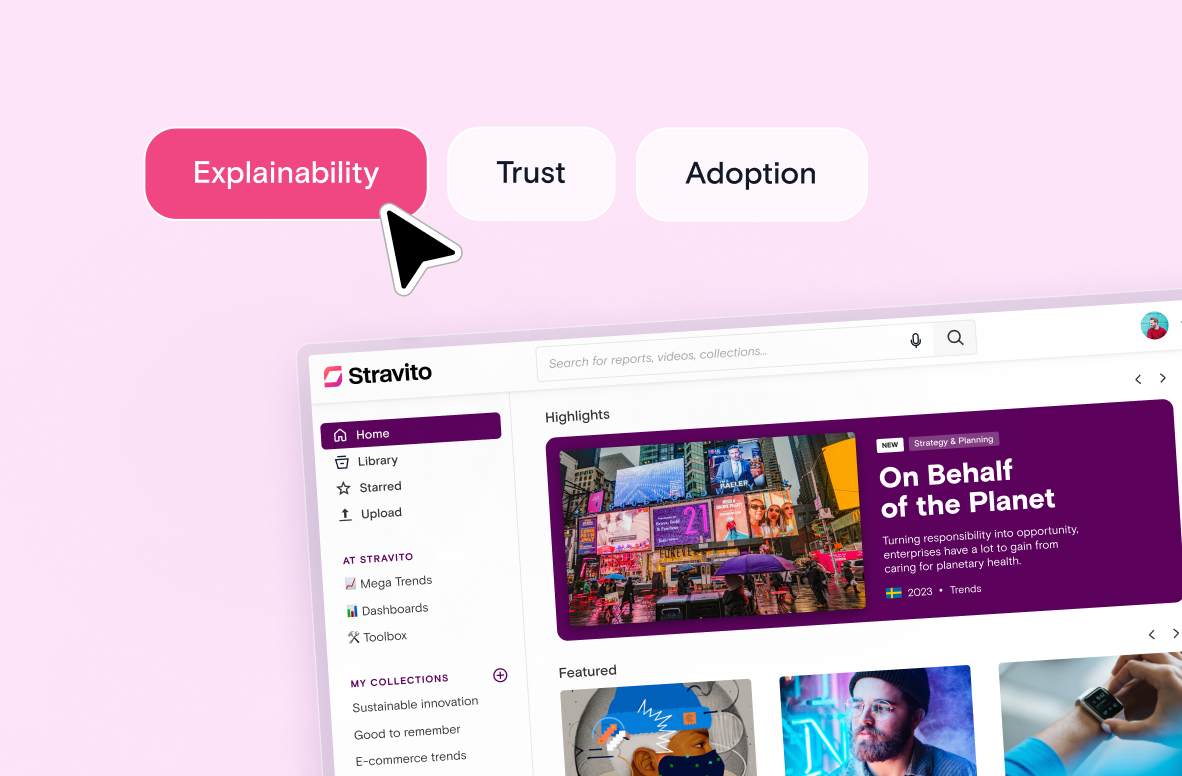TL;DR:
- Knowledge management is the practice of capturing, organizing, and sharing knowledge so it fuels smarter decisions.
- A modern knowledge management system goes beyond storage to support discovery, collaboration, and knowledge sharing.
- Benefits include faster decisions, stronger customer satisfaction, and higher productivity across global teams.
- Companies like HEINEKEN, La-Z-Boy, Shell, and NPR show how modern KM unlocks tacit knowledge and makes organizational knowledge accessible.
- The right system democratizes insights, avoids duplication, and turns your collective knowledge into a competitive edge.
Struggling to get the most out of your research and insights?
You’re not alone.
Many enterprises find that valuable knowledge ends up scattered across tools, buried in folders, or stuck in someone’s head.
If that sounds familiar, here’s the good news: there’s a way to fix it.
Knowledge management helps your teams unlock and reuse insights so they can work faster, collaborate better, and make decisions with confidence.
Want to scale insights across your company without drowning in files? Knowledge management is how you do it.
Let’s define things first.
What is knowledge management?
Knowledge management is the practice of capturing, organizing, and applying knowledge so your teams can use it to make smarter decisions.
It provides a structured way to turn scattered information into something useful, actionable, and lasting.
At its core, knowledge management means unlocking your company’s collective knowledge.
That includes:
- Explicit knowledge (like reports and presentations)
- Tacit knowledge (the know-how your employees build over time)
- Implicit knowledge (unwritten practices that could be documented).
Connecting all three helps your business preserve intellectual capital, encourage knowledge creation, and reduce duplication.
When you’re designing a knowledge management framework, think about how these types of knowledge will flow together to create real business value.
Knowledge management vs content management vs enterprise search
It’s easy to confuse knowledge management with other tools that organize information, but each serves a different purpose:
- Content management → Useful for publishing and storing digital content like webpages or marketing materials, but not designed for insight discovery.
- Enterprise search → Helps retrieve documents across multiple systems, but lacks the structure or context that turns information into insights.
- Knowledge management → Purpose-built to capture, organize, and socialize knowledge so your teams can apply it.
The difference between content management vs knowledge management is critical when you’re evaluating options. Knowledge management isn’t just about locating a file. It’s about activating knowledge so your teams can make better decisions every day.
Why knowledge management matters in 2025
If your company is struggling to reuse research, align teams, or keep track of insights, chances are valuable knowledge is getting lost in silos. Without proper knowledge management, organizations face wasted budget, slower decisions, and missed opportunities.
That’s why knowledge management is more than a back-office tool. It’s a core part of business performance in 2025.
Signals you need KM now
These warning signs suggest your company is missing out on the benefits of knowledge management:
- Duplicate research → teams repeat studies because earlier findings can’t be located in your knowledge management system.
- Deck sprawl → insights sit in hundreds of slide decks, with no centralized repository.
- Slow onboarding → new employees lack easy access to critical information and knowledge base articles.
- Repeated questions → your support team and insights team spend time answering the same requests instead of creating new knowledge.
- Multilingual fragmentation → research created in one market never reaches colleagues in another, reducing the value of your enterprise’s information assets.
When these issues pile up, they create real barriers to growth.
But the good news is that the same patterns that signal a problem also point to the knowledge management benefits your company can unlock with the right system.
Outcomes you can expect
With the right approach, the advantages of knowledge management are clear:
Faster decisions: A good knowledge management system makes relevant knowledge easily accessible so teams can act quickly.
Fewer repeated studies: Existing knowledge is reused instead of recreated. HEINEKEN, for example, avoided duplicate research by scaling their knowledge management process across 70 markets.
Stronger launches: Marketing and product teams align around the same insights, improving customer experience and helping to increase customer satisfaction.
Compliance control: Sensitive documents are governed properly, reducing the disadvantages of knowledge management, such as inconsistent handling of stored knowledge.
Better stakeholder trust: Leaders gain confidence when decisions are based on your organization’s collective knowledge, not guesswork.
When you define knowledge management as a driver of company-wide performance, the payoff is clear.
Proper knowledge management benefits your business by boosting productivity, reducing customer support costs, and helping teams share and apply knowledge effectively.
So how do you make this real?
It starts by understanding what a knowledge management system is and how different types of knowledge management systems support your strategy.
What is a knowledge management system
A knowledge management system (often shortened to KMS) is the technology that helps your company capture, organize, and share knowledge at scale.
It is the backbone of any knowledge management strategy because it turns scattered files into a single, accessible source of truth.
So, what is a knowledge management system in practice?
It is the bridge between information and action: the place where your teams can find insights quickly, reuse past research, and avoid wasted effort.
A knowledge management system makes knowledge reusable and valuable across your business.
Types of knowledge management systems
There are several types of knowledge management systems, each designed for different purposes:
- Document management systems → Focused on storing and retrieving files, but often limited in collaboration features.
- Content management systems → Useful for publishing and communication, but not optimized for insight discovery.
- Vertical knowledge management platforms → Purpose-built for specific domains like consumer insights or R&D, making it easier to apply tacit knowledge and answer customer questions.
So, what are knowledge management systems overall?
They are tools that balance storage with discovery, connect explicit and tacit knowledge, and make valuable knowledge easily accessible to everyone.
Choosing the right knowledge management system is critical. A good system supports collaboration, reduces customer support costs, and creates a centralized repository your teams will actually use.
With the system defined, the next step is to look at the knowledge management benefits your business can expect across the enterprise.
Benefits of a knowledge management system
A knowledge management system delivers measurable advantages for your business.
It goes beyond storing files to create real efficiency, stronger collaboration, and better performance across the enterprise.
Knowledge retention
Without a central system, valuable expertise leaves when employees move on.
A knowledge management system captures tacit knowledge, explicit knowledge, and even embedded knowledge so it can be reused.
This protects your organization’s information assets and ensures knowledge transfer between teams.
Faster training and onboarding
An internal knowledge base with clear knowledge base articles and how-to articles gives new employees a head start.
Instead of relying on tribal knowledge, your company can use a self-service knowledge base to support employee training, reduce repeated questions, and cut time-to-productivity.
Better customer experience
A good knowledge management system lowers customer support costs by making accurate information easily accessible.
Your support team can answer customer questions faster, improve customer interactions, and increase customer satisfaction with every touchpoint.
Higher productivity across teams
When knowledge is stored in one centralized repository, your teams spend less time searching and more time doing.
Continuous improvement becomes easier when insights are visible, knowledge reviews are consistent, and all the knowledge is available to inform decisions.
Stronger business performance
The advantages of knowledge management systems show up in company-wide results.
From faster launches to better customer experience, KM benefits translate into higher productivity, reduced costs, and measurable gains in business performance.
With these benefits in mind, it is also important to recognize the challenges of knowledge management and how to avoid them.
Challenges in knowledge management
Even the best corporate knowledge management programs face hurdles.
Without the right setup, knowledge management systems can slow teams down instead of making work easier.
These are some of the most common challenges in knowledge management (and how to overcome them).
Information overload
When companies try to capture everything, they create noise instead of clarity.
- Unstructured knowledge piles up without summaries.
- Valuable insights get buried in long reports.
- Employees lose trust if they cannot find accurate information quickly.
Fix: Set rules for what to capture. Every asset should have a clear summary, owner, and tags so it remains usable.
Poor integration with existing systems
A knowledge management system that does not connect with your existing systems becomes another silo.
- Knowledge is scattered between drives, intranets, and email chains.
- Teams are unsure which version of stored knowledge is correct.
- The company misses opportunities to get more from all the knowledge it already has.
Fix: Choose a system that integrates with your existing tools and creates a single source of truth. This keeps knowledge accessible without duplicating work.
Weak knowledge organization
If a system lacks consistent tagging or intuitive search, it fails to deliver value.
- Teams waste time on duplicate research.
- Embedded knowledge from experts is never captured.
- Knowledge reviews are inconsistent, limiting continuous improvement.
Fix: Keep taxonomy simple. A shared glossary, consistent tags, and quarterly reviews keep the system clean and trustworthy.
Low adoption and engagement
The biggest risk is that people simply do not use the system. If employees cannot see value, they will not contribute or search for insights. This is where knowledge management projects often stall.
Fix: Embed knowledge sharing into daily work. Use role-based digests, highlight wins where insights drove outcomes, and make the system part of onboarding so adoption grows naturally.
Strong knowledge management implementation solves these issues.
With clear governance, training, and processes that make knowledge sharing part of daily workflows, adoption grows naturally, and your company realizes the benefits of a knowledge management system.
Once these challenges are addressed , the next step is understanding how to implement and adopt knowledge management effectively.
How to implement and adopt knowledge management
Rolling out a knowledge management system can feel daunting, but it does not have to be.
A clear knowledge management implementation plan helps your company build momentum, prove value early, and set habits that last.
Your first 90 days
Start small, focus on essentials, and scale as adoption grows.
Days 1–30: Foundation
- Anchor the rollout on three business questions:
- How can we reuse past research to save costs?
- How do we improve speed to market?
- How do we ensure insights reach the right teams?
- Import the top 100 most valuable assets into your internal knowledge base.
- Define a simple glossary and tags to keep knowledge organization consistent.
- Create three Collections tied to active business needs.
- Set basic permissions to manage access and security.
Days 31–60: Activation
- Connect BI links and other existing systems.
- Launch digests tailored for different audiences.
- Train at least ten champions across teams.
- Publish a checklist so every new upload includes a summary, tags, and owner.
Days 61–90: Scale
- Add vendor and analyst studies.
- Upload competitive snapshots and market updates.
- Roll out “insight to action” briefs for stakeholders.
- Run your first knowledge review for recency and reuse.
- Publish an early ROI snapshot to prove impact.
You can also check out how to create a knowledge base for a deeper dive.
With 100 core assets, clear tags, and simple summaries, you will have a foundation people trust and actually use.
From rollout to adoption
The first 90 days are about setting the system up for success.
But long-term value only comes when your company embeds knowledge management into everyday decisions. That is where function-specific playbooks help. They show each team how to make the system part of their workflow, so adoption grows naturally.
Product and UX
- Plan every sprint with a Collection of relevant insights.
- Use feature briefs that cite research to align stakeholders.
- Share usability findings so lessons are reused across markets.
These practices ensure product decisions are grounded in customer knowledge, not assumptions.
Sales and Success
- Keep a win–loss library that captures customer insights.
- Tie objection handling to recent research.
- Align enablement resources with themes surfaced from the last quarter.
With this approach, your sales and success teams can respond faster to customer needs and turn insights into revenue.
Marketing and Brand
- Anchor message houses in real consumer quotes.
- Package regional insights into toolkits for local teams.
- Reuse creative testing results to save time and avoid duplication.
The result is consistent, insight-driven campaigns that connect with audiences in every market.
Leadership
- Share a monthly “Insight in 5” digest: three metrics, three quotes, three decisions.
- Track adoption metrics to reinforce the value of knowledge sharing.
- Highlight success stories where insights directly supported strategic choices.
When leaders set the tone, knowledge management becomes part of company culture and a driver of business performance.
With the right foundation and tailored playbooks, your company can move from setup to true adoption. You'll make knowledge management a living part of your culture, not just another system.
How AI improves knowledge management tools
AI is transforming the way companies capture, enrich, and share knowledge.
Instead of acting as passive archives, modern knowledge management systems use AI to surface insights, reduce manual work, and make knowledge easier to apply.
Where AI helps
AI expands the benefits of knowledge management by automating repetitive tasks and improving discovery. Modern knowledge management tools now include features like:
- Auto-tagging and duplicate detection to keep repositories clean.
- Summaries with citations that help teams understand long reports faster.
- Translation and multilingual abstracts to make knowledge accessible across markets.
- Semantic search, machine learning, and entity extraction to reveal connections that might otherwise be missed.
- Support for answering customer questions by highlighting related insights.
These capabilities save time, create new knowledge pathways, and help your teams focus on applying insights instead of chasing them.
Guardrails to keep in place
AI can accelerate insight sharing, but it needs the right boundaries.
- Outputs should be permission-aware and link back to original sources.
- Personally identifiable information must be redacted to protect compliance.
- Bias checks and human approval are essential for high-impact use cases.
Guardrails ensure AI delivers accurate information and supports knowledge sharing without putting your company at risk.
Looking ahead, the future of knowledge management will be defined by how enterprises balance automation with human judgment.
AI makes knowledge management faster and smarter, but your people will always provide the context, creativity, and decisions that turn insights into business outcomes.
Now it's time to take a look at how businesses like yours found success with knowledge management.
Knowledge management in action: Real-world examples
Corporate knowledge management delivers the most impact when it is rooted in real use cases.
Global enterprises across industries have shown how the right system turns scattered information into shared insight.
HEINEKEN: scaling insights globally
HEINEKEN built a central platform for consumer and market knowledge. By reusing existing research instead of repeating it, their teams saved more than €900,000 worth of time.
The system freed employees to focus on strategic work and helped the company scale insights across more than 70 markets.
La-Z-Boy: becoming more consumer-centric
La-Z-Boy needed to put the voice of the consumer at the center of decision-making.
With Stravito, the team created a knowledge hub that made research easy to search, browse, and share. The result was faster product development and a stronger link between consumer insights and business outcomes.
Shell: driving adoption across a global enterprise
Shell relaunched its Heartbeat platform with Stravito to replace outdated systems. Adoption tripled in the first year, proving the value of a system built for insight sharing rather than simple storage.
Today, teams use curated Collections to explore themes from EV charging to snacks, turning knowledge into a resource that drives everyday decisions.
NPR: creating a single source of truth
NPR’s Audience Insights team needed a way to serve stakeholders across the organization.
With Stravito, they built a single source of truth that became part of the research process itself.
As Lori Kaplan, VP of Audience Insights at NPR, says:
“It’s not done until it’s in Stravito.”
By embedding insights into daily workflows, NPR ensured that knowledge was not just stored but actively used.
These examples show that when knowledge management tools are applied well, the benefits are tangible:
Time saved, adoption increased, and better decisions made across the business.
KPIs and ROI you can champion
Knowledge management delivers real business value, but leaders often ask how to measure it.
The best place to start is by defining the right KPIs for adoption and impact.
Many companies look at knowledge management KPIs, such as time saved or reuse of assets, to show progress in the early months.
Leading indicators
Leading indicators track early signals that your system is being used and trusted. Examples include:
- Time to find prior work
- Percentage of assets with summaries and tags
- Digest open rates
- Collection reuse across teams
These metrics help you confirm whether your system is building healthy knowledge-sharing habits.
Lagging indicators
Lagging indicators show the impact of knowledge management on performance. Examples include:
- Duplicate studies avoided
- Launch or fix cycle times reduced
- Win rate or churn improvements
- Rework reduction
These KPIs prove that knowledge management enhances company performance and drives measurable business outcomes.
A simple ROI model
When it is time to make the business case, a clear ROI model connects knowledge management benefits directly to cost savings and growth.
Our guide on knowledge management ROI explains how to calculate value in a way that resonates with finance and IT.
Benefit = (Hours saved × blended rate) + (Duplicate study costs avoided) + (Conversion or retention lift × LTV)
ROI = (Benefit – Program cost) ÷ Program cost × 100
With a clear ROI model, your company can show measurable value from knowledge management. But it is important to recognize that the specific drivers of ROI vary by industry.
In some sectors, the stakes are especially high where compliance, safety, and efficiency depend directly on how well knowledge is managed.
High-stakes use cases: Healthcare and manufacturing
Some industries face higher risks when knowledge is not managed well. Healthcare and manufacturing are prime examples.
In both, the quality of knowledge management directly affects compliance, safety, and performance.
These sectors highlight what can happen when knowledge is siloed and what is possible when it is shared effectively.
Healthcare and life sciences
In healthcare, accuracy and compliance are everything.
Insights move through strict MLR workflows and often need to be translated for different audiences, from HCPs to patients.
Knowledge management fails when organizations face compliance breaches, delayed approvals, and poor decisions due to incomplete information.
Knowledge management in healthcare ensures that insights are accurate, audit-ready, and accessible, protecting both compliance and patient trust.
Manufacturing
Manufacturing runs on consistency and rapid response.
Plants and suppliers generate a steady stream of data, EHS reports, and lessons learned.
Without effective knowledge management, companies experience quality issues, suffer downtime, and increase safety risks when knowledge stays siloed.
Knowledge management in manufacturing helps capture and reuse critical insights across sites, suppliers, and teams, reducing risk and improving efficiency.
These high-stakes use cases show how flexible knowledge management can be.
Whether your business is in healthcare, manufacturing, or beyond, the same principle applies - the better your knowledge is managed, the stronger your results.
Now, it's time to find the right partner to make your knowledge management journey seamless.
How Stravito helps enterprises scale and socialize insights
To unlock the full benefits of knowledge management, you need a system designed for everyday use. Stravito was built with that goal in mind.
Centralize and connect knowledge
Stravito brings all your research, competitive intelligence, analyst reports, and customer data into one place. With a centralized repository, your teams no longer waste time searching across drives and email threads.
Discover and compare insights
Semantic search makes it easy to find relevant knowledge across PDFs, decks, and videos. Teams can compare findings across markets and build Collections that support launches, pricing strategies, or churn analysis.
Enrich and socialize information
With Stravito Assistant, AI helps summarize reports, suggest tags, and highlight connections. Digests and comments make knowledge social, so insights reach the people who need them most.
Govern with confidence
Enterprise-grade governance gives you control with permissions, audit trails, and retention policies. Sensitive information is protected, while knowledge remains accessible for those who need it.
The result: a system your employees actually use.
One that boosts productivity, builds trust, and turns knowledge into measurable business performance.
See Stravito in action
Your business creates valuable knowledge every day. Stravito helps you put it to work.
Request a Stravito demo to see how global enterprises use it to scale insights, reduce waste, and make smarter decisions faster.
FAQs
What is knowledge management?
Knowledge management is the practice of capturing, organizing, and sharing knowledge so your teams can use it to make smarter decisions.
It helps turn scattered information into valuable knowledge your company can act on.
What is a knowledge management system?
A knowledge management system is the technology that supports this process.
It provides a centralized repository where research, insights, and documents are stored, searched, and reused across the business.
Why is knowledge management important?
Without proper knowledge management, companies face duplicated research, wasted time, and knowledge loss when employees leave.
A strong system ensures knowledge retention, boosts productivity, and improves customer experience.
How is knowledge management different from content management or enterprise search?
Content management systems are built for publishing and sharing files. Enterprise search helps locate documents across tools.
Knowledge management systems combine both functions with context, summaries, and collaboration features so insights can be applied.
What are the benefits and challenges of knowledge management?
The benefits of knowledge management include faster decision-making, stronger collaboration, lower customer support costs, and better business performance.
The challenges include information overload, poor integration with existing systems, and low adoption if knowledge sharing is not embedded in daily work.




